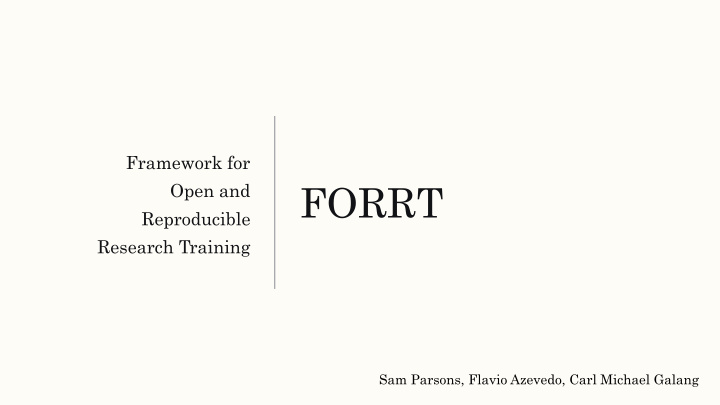



Framework for FORRT Open and Reproducible Research Training Sam Parsons, Flavio Azevedo, Carl Michael Galang
FORRT sale’s pitch The promised How? The enemy Why now? Obstacles land Bad Research Scientific Credibility FORRT Science Nirvana Training Crisis
Questionable Research Practices (QRPs) Q-Measurement-Ps P-Hacking Data Hogging HARKing Publication bias Nefarious Incentives Underpowered studies The Enemy
Why now? Reproducibility Questionable Misaligned Re-evaluation Crisis Research Incentives
Funder, Institution, Journal led Student ECR led Why Now? Initiatives!
The Promised Land Open Restructured Cumulative Crowdsourced Scientific Incentives Communication Pillars of Academic Nirvana (Nosek et al., 2012, 2012, 2018) The Psychological Science Accelerator (Chartier, 2016-Forever) Becoming Cumulative Science (Mischel, 2009)
Obstacles Current teaching practices
Obstacles Teaching subject-matters without: – probabilistic uncertainty – research design – Samples (type & quality) measurements –
Obstacles & Consequences Collaborative Crowdsourced Future scholars Future Consumers of science Citizen
HOW? FORRT Framework for Open and Reproducible Research Training
HOW? Main Motivation ____________ Teaching of reproducible and open research practices is the clearest indicator of the degree to which institutions and/or departments embody principles of credible science.
HOW? Only Resource Tool (or resource gateway) for Faculty/Institutions Two goals 1. Assessment 2. Resource
FORRT Assessment 6 core principles Reproducibility and replicability knowledge – Conceptual and statistical knowledge – Reproducible analyses – Preregistration – Open data and materials – Replication research –
FORRT Assessment Breadth describes how widely teaching is distributed None. Not yet enacted, minimal breadth, or no evidence – Some. Opportunities for some. – Course requirement for all. – Depth describes the degree to which students interact with the core: None. Not yet enacted, minimal depth, or no evidence – Knowledge. – Practice. – Application. –
FORRT Resource Gateway Curated – Reproducibility and replicability knowledge – Conceptual and statistical knowledge – Reproducible analyses – Preregistration – Open data and materials – Replication research – Crowdsourced – As above –
FORRT www.forrt.netlify.com
FORRT Initial (and tentative) steps to join FORRT Here's a minimal template to enlist your substantive course – on any discipline in social sciences – on FORRT. Please send it to FORRTproject@gmail.com. For information about FORRT’s tentative implementation plan, follow this link and click on the tab “Implementation Plan.” FORRT project invites interested scholars to participate in the further development of it’s concept as well as in expanding its scope to social sciences more broadly. We currently have a draft manuscript for which we are collecting feedback. If you would like to contribute in any way, please consider commenting in our early draft or emailing us at FORRTproject@gmail.com.
Thank you ☺ FORRT is a collaborative project born out of a workshop during the annual meeting of the “Society for the Improvement of Psychological Science” (SIPS) at Grand Rapids (US) in 2018 with the outstanding and wonderful collaboration from: Sam Parsons Carl Micheal Galang @ Sam_D_Parsons @ MyEngrams Experimental Psychology Social Brain, Body and Action Lab at University of Oxford at McMaster University.
Recommend
More recommend